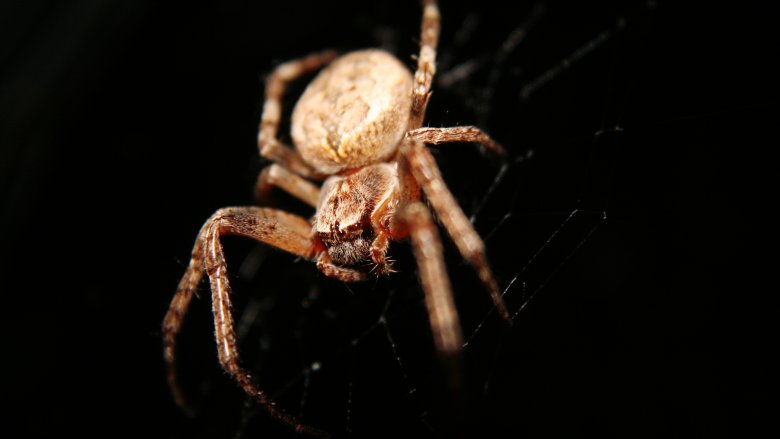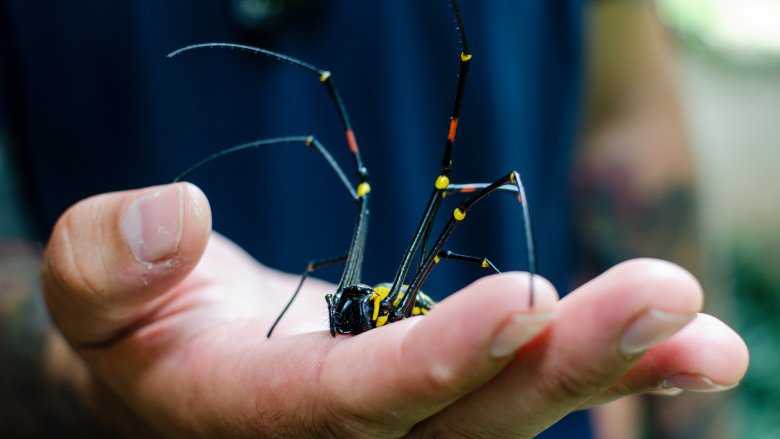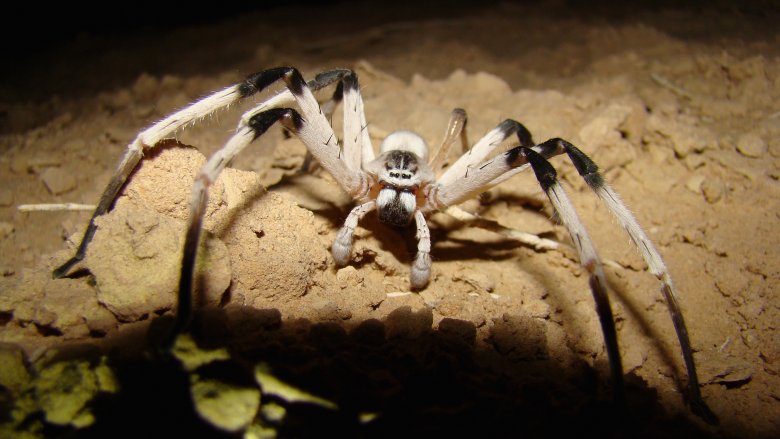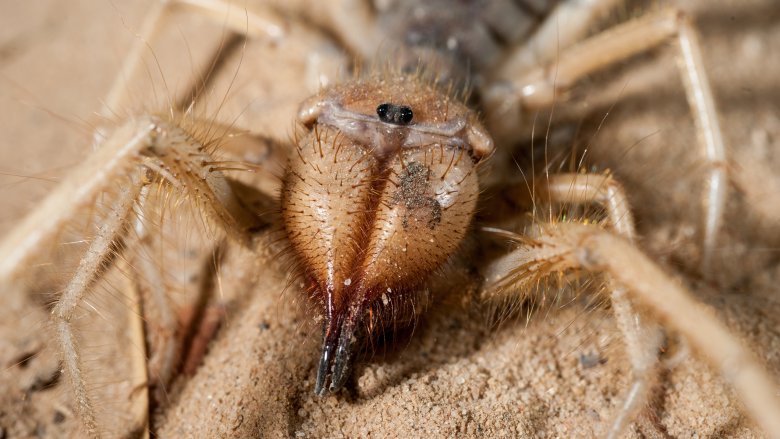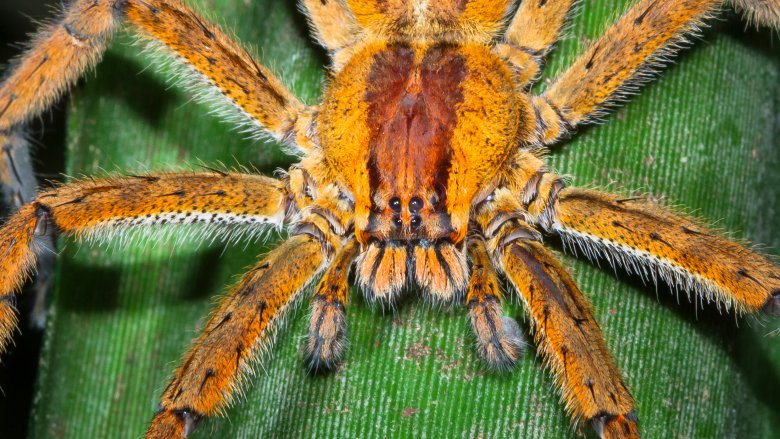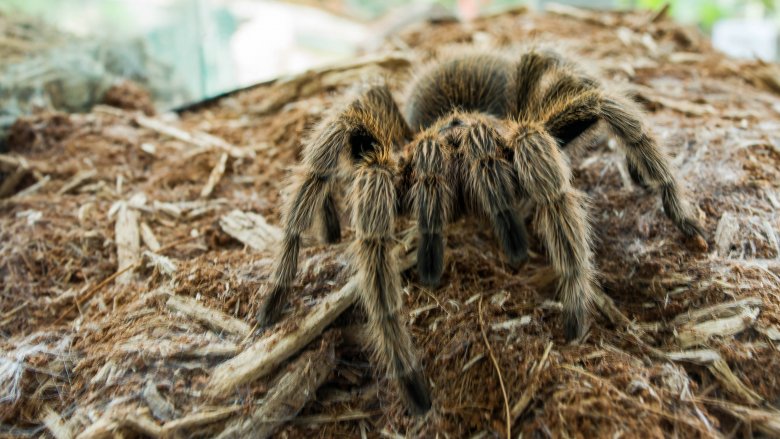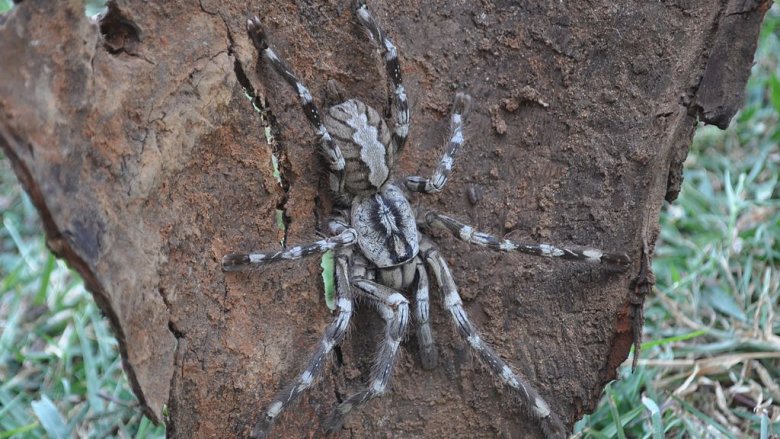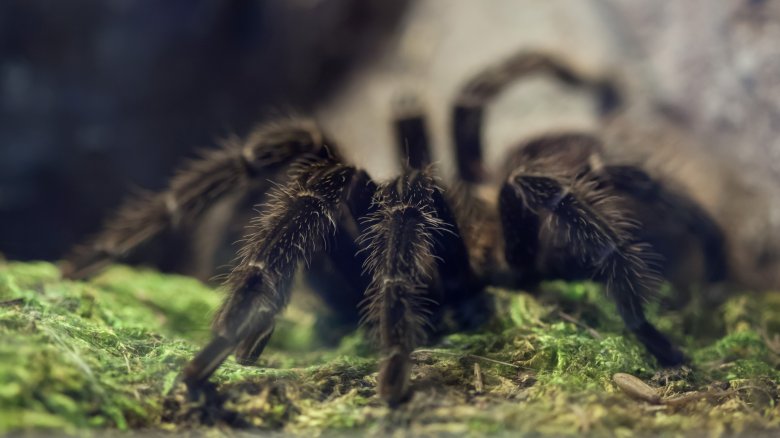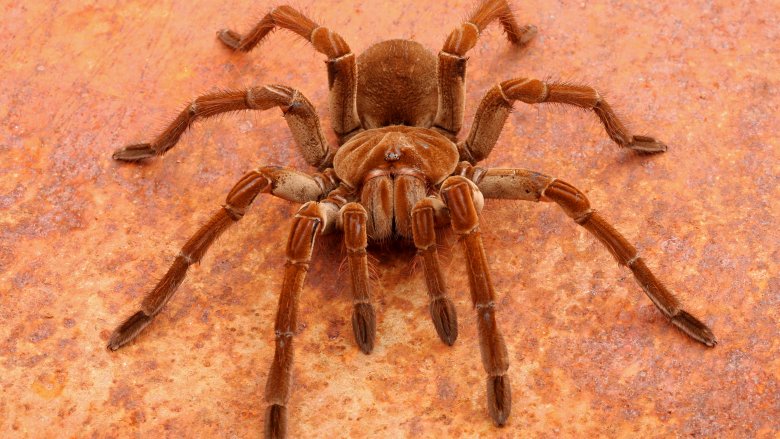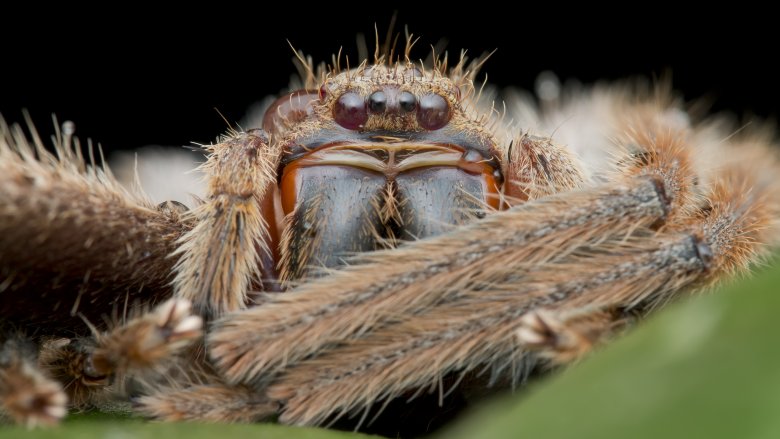These Are The Biggest Spiders In The World
You probably think the biggest spiders to ever walk the Earth lived in prehistoric times because back then everything was bigger, from wolves to sloths to camels. Perhaps you derive a certain sense of security from knowing giant spiders are all happily extinct, dwelling only in our imaginations and on the pages of books written by people who don't seem to care how many readers suffer permanent psychological damage after reading them. (Thanks, J.K. Rowling.) And that's how you manage to sleep at night, safe in the knowledge that the scrabbling sound at your front door is just the branches of a tree blowing in the wind, and not a giant, man-eating spider trying to get inside.
Here's the truth about giant prehistoric spiders: The longest remaining leg of the largest fossilized spider ever found was a whopping 2.3 inches long, which looks like cake next to some of the giant spiders we know today. Now, giant spiders still might have existed in prehistoric times — perhaps we've just never found any evidence of them. But until we do, the world's largest known spiders are actually modern spiders. What's that scrabbling at your window again?
What exactly is that spider trying to catch with its 3-foot web?
So let's start our horrifying tale of horror with the eensy-weensy Nephila komaci, a species of golden silk orb weaver. Females of this species have a leg span of between 4 and 5 inches. In case you need some perspective, that's roughly the diameter of a typical chocolate chip cookie. If you're nervous already, please take note that this is the first spider on our list and we're going from smallest to largest, so you may want to go find yourself a paper bag to breathe into.
According to Wired, the first live N. komaci wasn't officially discovered until 2007, despite unidentified specimens showing up in museum collections since 2000. In addition to being among the biggest spiders, it's one of the rarest spiders in the world. It's native to the African continent, including Madagascar, and it might already be critically endangered since only three live specimens have ever been found and it is only known to live in a single forest in Tembe Elephant Park in KwaZulu-Natal, South Africa. And in that forest, the spider weaves a big ol' 3-foot web. Yes, that's right. Three feet. That's more than big enough to capture a Hobbit and Harry Potter, though maybe not on the same afternoon. Scientists, we know how you love your new species discoveries and all, but maybe some creatures should remain undiscovered.
Can't we just leave them on that unpopulated island?
Another critically endangered spider is the Desertas wolf spider. This charming creature is black with gray spots, lives on Deserta Grande Island in Portugal's Madeira archipelago, and has a leg span of 5 inches, or about the size of one of those personal chicken pot pies you can get in the frozen section of your supermarket for 99 cents. Remember we are only on number two.
There are probably around 4,000 Desertas wolf spiders left in the wilid, which is 4,000 too many. We really want to care about endangered spiders, but it's just so much easier to care about fennec foxes and sand cats and cute things that do not have eight legs and a lust for human flesh. And yes, we know spiders don't usually lust for human flesh, at least not where scientists can see them.
According to the BBC, the Bristol Zoo is trying to help the species with a captive breeding program, and if you've ever seen a photograph of a mother Desertas wolf spider covered with a swarm of horrifying miniature Desertas wolf spiders, you know there has to be some sinister spider-to-human mind control happening with those zookeepers since no one in their right mind would do such a thing on purpose. Anyway. Good luck to the very endangered Desertas wolf spider. Hopefully it rebounds and then never leaves the island.
It would be pretty if it weren't so hideous
There are so very many things about giant spiders that are just too horrible to comprehend, like everything to do with any of them. But one thing that's especially horrible is that so many of these giant spiders were unknown to humans before the turn of the century. How do people totally fail to notice the existence of a giant spider of any kind? No matter how big they are, spiders always find a way to get inside your house. And it's worse because that means there could be an undiscovered species of spider almost anywhere, including your backyard, and scientists might actually make that landmark discovery only when your family finds your bones picked clean after said undiscovered species emerges from your tool shed one fine summer afternoon.
Now that you're wide awake, let's talk about Cerbalus aravensis, an enormous spider with a 5.5-inch leg span — roughly the diameter of a corn tortilla. Cerbalus aravensis was first observed in 2007 on the Israel-Jordan border, and its existence was reconfirmed in 2010. Not too much is known about the spider; it's nocturnal, lives underground at the edges of salt marshes, and preys on insects and lizards using a devious trapdoor into its den. It's also most active during the summer. Its one and only habitat is also being destroyed by mining projects, so look out: Cerbalus aravensis might be looking to relocate.
It almost certainly doesn't eat camels
So a giant camel spider isn't technically a spider. It's an arachnid, which is the class of animals that includes spiders, scorpions, and ticks, so basically everything horrible that lives on our planet. Anyway for the sake of this list we're going to say they're close enough to actual spiders because they look like spiders, they behave like spiders, and according to National Geographic, they "utilize digestive fluids to liquefy their victims' flesh, making it easy to suck the remains into their stomachs," so at this point who cares if they're technically a spider or not.
Despite the name, camel spiders do not eat camels. According to LiveScience, they eat bugs, lizards, rodents, and small birds, which admittedly is not as horrible as eating a camel but is still pretty horrible. The giant camel spider lives in the Middle East and has a leg span of up to 6 inches, which is roughly the diameter of the pita bread you put your falafel in a couple weeks ago.
Camel spiders don't have venom, but a bite from one is still painful. They can run up to 10 miles an hour, which is about one-third as fast as the fastest human but at least twice as fast as the average American couch potato, so just in case you really needed another reason not to go to the Middle East, there it is.
Don't read this unless you already don't like bananas
Guess what, that story about the family who found a giant spider in their bananas was not an urban legend. According to The Guardian, it's true, so just go ahead and take a couple deep breaths into that paper bag now.
The Brazilian wandering spider is not only one of the world's largest spiders, it's also one of the most venomous, capable of delivering a painful bite that can paralyze small prey. The bite requires antivenin, but most of these spiders don't inject enough venom into humans to require treatment. So if the one hiding in your bananas bites you, you have absolutely nothing to worry about! Ha.
The Brazilian wandering spider has a 6-inch leg span, which is about the size of a personal pizza. Now, terrifying spiders hitching a ride on bananas and not only putting thousands of people entirely off bananas for the rest of their lives but also forcing them to completely circumvent the tropical fruits part of the produce section every time they go to the grocery store from now until the end of time isn't something that happens very often because banana importers are careful to despiderize all their shipments. How one of those monsters actually got through is mystifying. Maybe those banana importers knew exactly what they were doing.
Hooray for urticating hairs and cartwheels of death
If you've ever dreamed of keeping a gigantic, terrifying, hairy spider as a pet (and who hasn't?) you can pick up a Colombian giant redleg online and have it shipped overnight to your home, with a guaranteed live arrival! Because spiders make awesome pets. You can snuggle them while you watch TV, you can walk them around your neighborhood on a leash, and you can laugh while they flick urticating hairs at you, because that's so adorable and endearing. In fact the giant redleg will even do a little circular dance lovingly nicknamed "the cartwheel of death" as it flings barbed hairs at your face and eyeballs. All this could be yours for $39.99.
The Colombian giant redleg tarantula is native to the tropical rain forests of Colombia and Brazil and has a leg span of between 6 and 8 inches, which is roughly the size of a Hungry Jack Complete Belgian Waffle, or your face. And if at some point you decide you don't like having urticating hairs flicked at you on a daily basis, you could always release your spider into the banana department at Safeway, just for a laugh. Note: We do not actually advocate releasing giant spiders into piles of bananas meant for human consumption, so please don't actually do that.
Lives in old trees and sometimes under hospital beds
Because the world absolutely needs another brand new species of terrifying spider, here's another that was unknown to science until well after the turn of this century. According to the Smithsonian, Poecilotheria rajaei was discovered in Sri Lanka in 2009, when villagers gave a dead one to a scientist who just had to go off and find more of them so we could all be extra terrified by the knowledge of yet another giant, venomous, previously unknown spider. These spiders like to hide in and under things, like wood piles, rocks, and your shoe. And during monsoon season, they like to go into people's houses.
Poecilotheria rajaei has a leg span of around 8 inches, which is roughly the size of a birthday cake. Happy birthday. A bite from spiders in the Poecilotheria genus can cause "severe muscle cramps lasting for days," plus "local swelling, erythema, and moderate to severe pain," but hey, the bite will probably will not kill you so just go ahead and try petting one if you happen to have an encounter the next time you are in Sri Lanka.
Scientists say Poecilotheria rajaei prefers to live in old-growth trees but deforestation is driving them into old buildings instead. In fact many of the first specimens were discovered living in a Sri Lankan hospital, which must have been so very comforting, especially to patients with limited mobility.
You can't buy them in pet shops (thank god)
The Hercules baboon spider is the rarest spider in the world, in fact no one has actually seen a Hercules baboon spider since 1900, and only one specimen was ever collected. Pet stores often claim to be selling "Hercules baboon spiders," but don't believe them. The ones sold in pet stores are probably the species' smaller cousin, the king baboon spider.
The Hercules baboon spider has an 8-inch leg span, so like Poecilotheria rajaei it is roughly cake-sized, although not much can be gleaned from that one specimen found more than 100 years ago. For all we know, the average Hercules baboon spider might be even larger, maybe even the size of an apple pie, or chocolate silk if that's what you prefer.
The Hercules baboon spider might be extinct, but it will likely be a while before anyone knows for sure, since it's native to Nigeria and its homeland is politically unstable — which means the people who live there aren't particularly interested in hunting down giant spider nests, and scientists can't really safely do it either. Though one does have to wonder why anyone would be hunting down giant spider nests at all, even in lands that are politically stable.
This one could probably eat a small puppy
Any spider called "birdeater" is already terrifying. The only name that could potentially be more terrifying than "birdeater" would be "Brazilian salmon pink small puppy eater" or "Brazilian salmon pink digests-its-prey-externally." The first of those two options is something this spider could probably pull off depending on the size and vulnerability of said puppy, and the second is the actual way tarantulas have breakfast, so go ahead and pick the one you like best.
The Brazilian salmon pink birdeater is not the biggest spider in the world, but it's up there, with a 10-inch leg span that makes it roughly similar in size to one of those giant burgers you get to have for free if you can eat the whole thing without vomiting.
If you're just dying to see a spider the size of a giant burger, you're in luck. Not only does the St. Louis Zoo have Brazilian salmon pink birdeaters in places where you can look at them, thus forever limiting your ability to sleep at night, but some poor zookeeper also has to clean out their cages, give them mice to eat, and probably dodge urticating hairs on occasion.
Brazilian salmon pink birdeaters are so named because they are covered with pink hair. So if you're shopping for a gender stereotypical tarantula for your tween daughter's bedroom, this is your species. Just don't also get her a puppy.
Roasted tarantula, anyone?
Just in case the salmon pink birdeater wasn't quite big enough for you, another option is the Goliath birdeater, which is not the largest spider by leg span, but is thought to be the largest spider by weight. The Goliath birdeater has a leg span of 11 inches, which is about as big as a family-size frittata that can feed five people with enough leftovers for the family dog, provided the Goliath birdeater has not eaten the family dog.
LiveScience describes the Goliath birdeater as being "as big as a child's forearm" and weighing "as much as a puppy." So now instead of just occasionally breathing into paper bags, we'll just attach them permanently to our heads.
The Goliath birdeater can weigh as much as 6 ounces, which is about the size of a decent filet mignon. Ironically, it is also one of the world's most delicious spiders, if you believe the indigenous people of South America, who like to roast Goliath birdeaters in banana leaves. If that's not horrible enough, diners like to use the spider's almost inch-long fangs as toothpicks after the meal. So they're a delicious food and also an important dental hygiene tool. Awesome. And according to National Geographic, they taste like prawns. Let's all agree to take their word for it.
Stay out of Laotian caves
Scientists are fond of saying that the giant huntsman spider is the size of a dinner plate, even though the average dinner plate is closer to the size of a Goliath birdeater. Twelve inches is either a slightly oversized dinner plate or a slightly undersized Thanksgiving turkey platter, so one could say that a giant huntsman is about the size of a roast turkey, except huntsman spiders are mostly leg and couldn't really feed more than one person.
Most non-giant huntsman spiders are a "modest" 6 inches or so. They're common in Australia, which is not surprising when you consider Australia is home to 95 percent of the world's things that can kill you, and makes up for that 5 percent deficiency with things that are so terrifying they kill you via heart attack. But according to Live Science, the giant huntsman (the biggest spider in the world) doesn't live in Australia — it's native to Laos, where it was first discovered in a cave in 2001. Yes, another enormous spider not known until this millennium. Truly, our curiosity will kill us.
Just in case you think one day you'll be able to sleep again, here's something to ponder. When you consider how many of the world's largest spiders were discovered in the last 20 years, it's probable that even more currently-unknown giant spiders will end up on this list in years to come. And the next one might be called "the American giant scrabbling-at-your-window spider." Sweet dreams.
